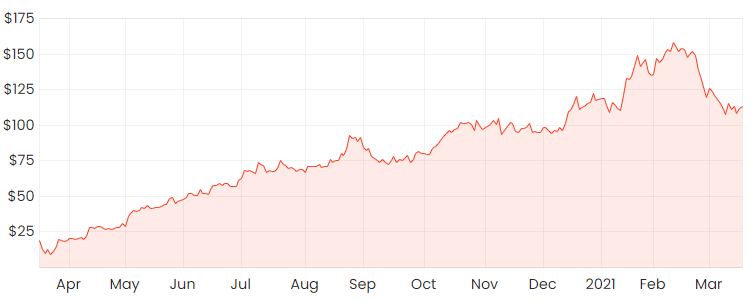Buy-now-pay-later (BNPL) companies such as Afterpay Ltd (ASX: APT) and Zip Co Ltd (ASX: Z1P) continue to be some of the most traded shares on the ASX in recent weeks.
After reaching highs of around $160 last month, Afterpay’s share price has fallen by roughly 35% of its current price of around $105 per share.
Here are three possible explanations of why Afterpay’s share price is falling.
APT share price

Increasing Competition
Afterpay is undeniably the market leader in the Australian BNPL industry with a considerable first-mover advantage over many of the smaller players.
Having said this, many have suggested BNPL companies may lack a sustainable economic moat that will give them an edge over a long period of time.
When we talk about economic moats, common examples of things could be things like switching costs, which make it costly or inconvenient for the consumer to switch to an alternative.
As a consumer, I would be indifferent about which BNPL company to choose in a transaction as the outcome is the same either way, which is a fixed amount of interest-free instalment payments.
I also don’t think merchants will be ‘forced’ into accepting Afterpay as a method of payment, given the number of rival products, which may offer a more competitive merchant fee.
Commonwealth Bank of Australia (ASX: CBA) has just recently announced its own BNPL offering.
Tougher regulatory environment
Compared to traditional payment methods such as credit and debit card, Afterpay charges the merchant a much higher rate at roughly 4% of the transaction value.
As it currently stands, Afterpay doesn’t allow merchants to surcharge, i.e., Increasing the transaction value by 4% to pass the cost onto the customer.
The RBA considered banning these rules surrounding surcharging in 2019, but decided to leave the current rules in place to encourage technology innovation. While BNPL’s have been spared, for the time being, the RBA has recently said that there may be a case for tighter regulation at some point in the future.
According to a 2019 consumer survey cited by the RBA, around 50% of respondents said they’d use a different payment method if a surcharge was imposed, 10% would cancel the purchase, and 40% would be happy to pay the surcharge.
Rising bond yields
The recent fall in technology company valuations has roughly coincided with the rise of the 10-year treasury yield roughly a month ago.
In the same way that tech-oriented growth companies have been some of the largest beneficiaries of a low interest rate environment over the past twelve months, any reversal of interest rate movements is likely to have the opposite effect on their valuations.
While this may have made checking your account balance fairly stressful recently, this might be an opportune time to buy some quality companies trading at more attractive prices.
I might not buy Afterpay at these levels though, but Altium Limited (ASX: ALU) is another ASX share that’s experienced a similar downtrend recently.
If you’d like to read more about Altium, click here to read: Will tech stocks crash in 2021? Here’s one ASX share I’d buy if they did.











